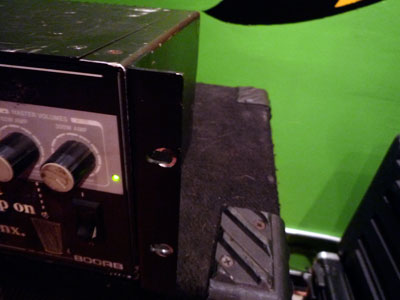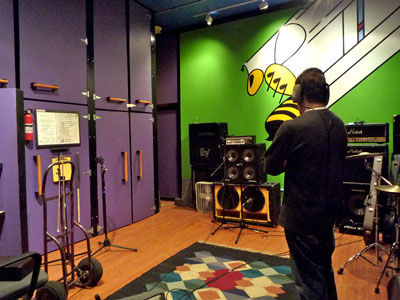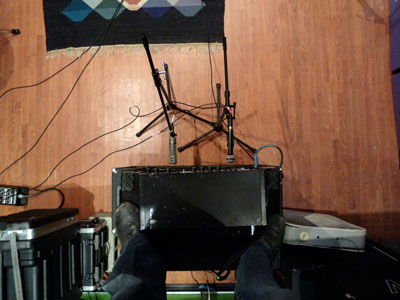|
06.07.09
Element 3 - Bass, direct
Making decisions about how to record a more acoustic instrument like the bass requires some focus. There are 2 cabinets to mic, four different sets of preamps, about eight mics and dozens, if not hundreds, of possible reasonable places to put each microphone. Consider also that these things interact with one another - a particular sound of the low part of the bass amp will sound different when blended with a different mic from the high part of the same amp.
To this end, we took stock and made a plan. We'd start by comparing mics, then preamps, then placement. The idea was to go from broad changes (differences between mics) to narrow ones (comparing mic positions of a few inches difference or less).
In the past, we've done this by playing the same part of a song over and over again, making the change as we went along. This time, I played the sound of the bass from the pedal directly onto tape (actually the DAW, but I'll call it tape for clarity). This was then "reamped" back to the bass rig - an output from the tape was patched into the amp itself. Rewind, hit play and the bass part is coming out of the amp cabinets, ready to be mic'ed over and over again. The sound was similar enough to what it sounds like actually playing the bass that it quickly became the preferred way to work, especially when it came time to make lots of small changes later on.
We started by comparing the sound of each mic in the same position - directly centered in front of the speaker cone and about 2 inches away from the grill, except as noted.
As noted in an earlier entry, the bass amp is bi-amped, with the 4x10 cabinet on top delivering the higher frequencies and the 2x15 cabinet delivering the lower frequencies. For this reason, we mic'ed each one separatetly and ran through the same set of choices for each: mic, preamp, placement.
Direct Microphone
CHOICES - HI
1. EV RE 20
2. Audio Technica 4033
3. Beyer m160
4. Josephson e22s
CHOICES - LO
1. EV RE 20
2. Audio Technica 4033
3. Josephson e22s
4. Earthworks TC30K - This was placed right up against the grill. Omnidirectional mics don't exhibit any proximity effect, so there's no danger of overwhelming bass by putting the mic close to the cabinet. It also minimizes the relative reflected sound vs. direct sound, which is desirable since it's close mic'ing the amplifier.
RESULTS
There are 16 possible combinations here. Rather than pull together a clip with so many choices that making a decision becomes impossible, I auditioned each of the elements separately - for the RE 20 on the Lo mic, which of the four Hi choices sounds best, etc. I then took each of these favorites and matched them against one another. The numbers on the sound clip are:
1. Hi: RE 20, Lo: RE 20
2. Hi: RE 20, Lo: e22s
3. Hi: 4033, Lo: 4033
4. Hi: 4033, Lo: TC30K
Bass - 4 way comparison of mic choices.
Same thing with drums and room mics (and later label).
The areas of distiction between the choices is much more apparent in the high end than in the low end. In fact the main difference between the high end almost sounds like someone's jacking up different individual slider of a graphic equalizer for each of the choices. It takes some concentration and listening to these again and again to hear beyond just that emphasis.
That noted, the real question is whether 1 & 2 sound better than 3 & 4. The 4033 empasizes the high end more than the RE20; the sound clips for the 4033 are certainly brighter sounding. Part of me wants to consider that this mic is centered right over the mic cone, which is the brightest sounding placement point. If I feel that this is too bright, I can always take some of the edge off of it later on through placement.
Still, I feel like the RE20's less pronounced attack cuts down on the staticky buzz that the 4033 brings in. As for which of the low end mics, I only have one RE 20 and so can't use it on both cabinets at the same time. Comparing clips one and two, I hear some more detail in the mid to low frequency area that adds clarity to what note we're playing.
DECISION AND NEXT STEPS
We'll use the RE20 for the high cabinet and the e22s for the low cabinet. The smoothness of the high end doesn't allow for me to brighten it up by getting closer to the middle of the cone, but I feel like this is about as bright as I'm going to want it. The e22s's detail in the low frequency areas is what we're looking for as well.
Next up, comparing preamps for these mics.
|
|  |
 |
 |



It feels kind of silly to do this late at night, by yourself. Just setting up machines to observe other machines, no one actually playing anything.

Woah! How did we take this picture? Dangerous!

|
 |
 |
 |
[ LATEST UPDATE ]
[ Archives ]
CONSTRUCTION
[ Overview ]
[ Basic Construction ]
[ Acoustics ]
[ HVAC ]
[ Electrical ]
[ The Grand Vision ]
[ Tool Reviews ]
[ Links and Resources ]
|